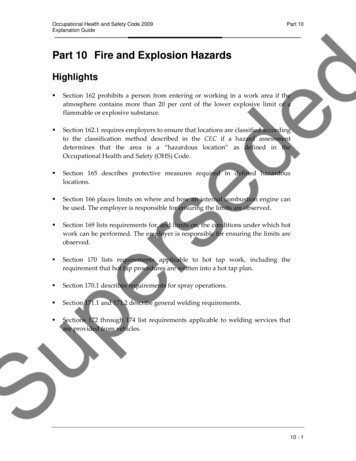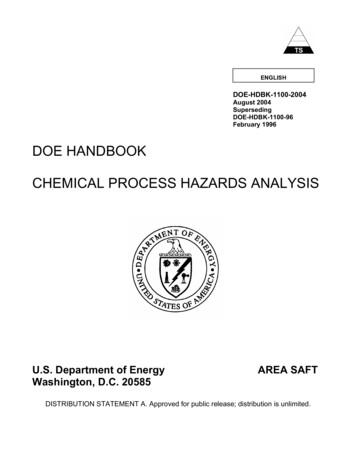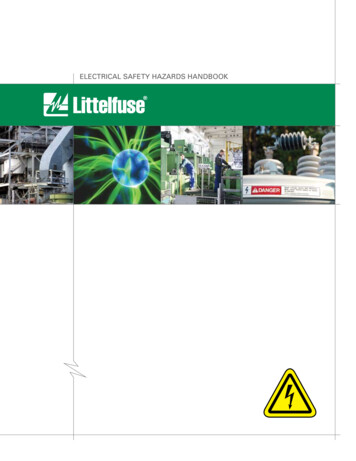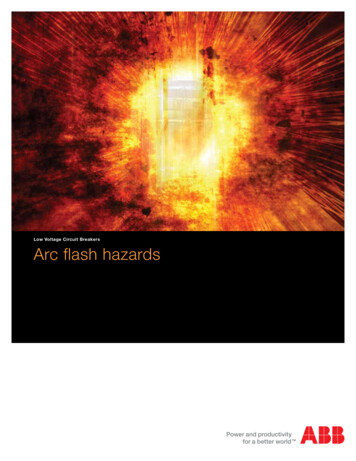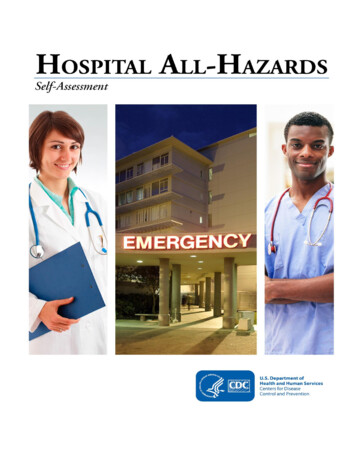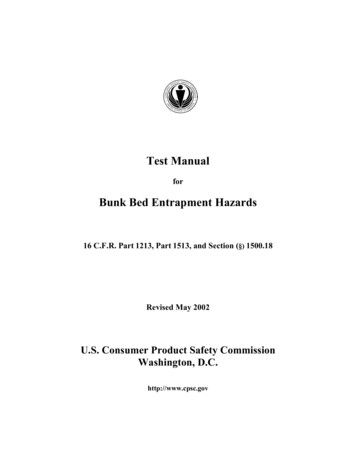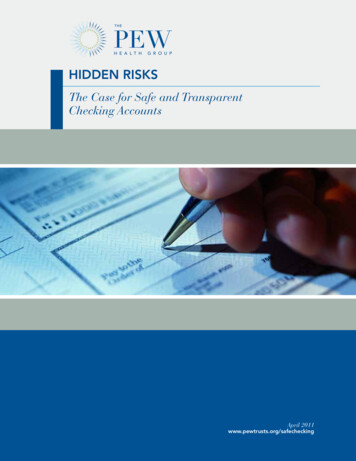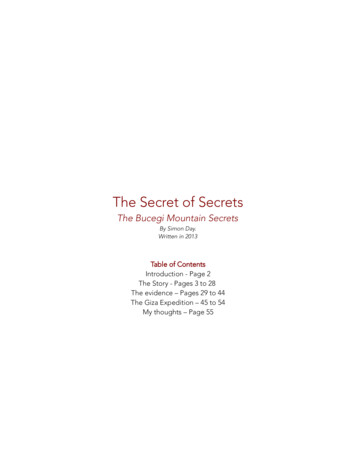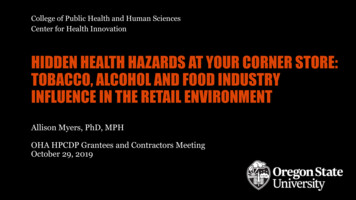
Transcription
College of Public Health and Human SciencesCenter for Health InnovationHIDDEN HEALTH HAZARDS AT YOUR CORNER STORE:TOBACCO, ALCOHOL AND FOOD INDUSTRYINFLUENCE IN THE RETAIL ENVIRONMENTAllison Myers, PhD, MPHOHA HPCDP Grantees and Contractors MeetingOctober 29, 2019
AcknowledgementsOREGON STATE UNIVERSITY COLLEGE OF PUBLIC HEALTH AND HUMAN SCIENCES
378,000 tobacco outlets nationwideTobacco products are sold inapproximately 378,000 locations in theUS including convenience stores, gasstations, grocery stores, andpharmacies.111,817 Starbucks US locations (2013)x 32 1. Center for Public Health Systems Science; POS Report to the Nation, 2014; Image credit James Davenport, ifweassume.com
7.38 billion or85% of industry spendingon price discounts in2017OREGON STATE UNIVERSITY COLLEGE OF PUBLIC HEALTH AND HUMAN SCIENCES
Retail is the tobacco industry’s lead marketing channelAdvertising and Promotional Spending (Annual- Billions USD)Tobacco Industry Spending in the Retail Environment9POS8 8.62 Billion/year on cigarettes andsmokeless ads & marketing in the retailenvironment (POS)7654321All Other0CigarettesPOSAll OtherSmokelessFederal Trade Commission Smokeless Tobacco Report for 2013. Washington, D.C. FTC File No. P114508Federal Trade Commission Cigarette Report for 2013. Washington, D.C. 2015.
What are they spending their billions on?Price discounts and promotionalallowances to retailers 7.9 Billion/YRSigns (advertisements), functionalitems, displays, shelving units 56 Million/YRCoupons 249 Million/YRFederal Trade Commission Cigarette and Smokeless Reports for 2013
All those billions get a return on investment.Exposure associated with/causalfactor of: Increased odds of ever smoking1, 2, 3 Increased odds of experimentalsmoking4 Increased odds of initiation5,6 Higher likelihood of becoming adaily or occasional smoker720122016Note well, Big Tobacco industrytargeting by demographics.1. Schooler, et al., 1996; 2. Henriksen, Feighery, Wang, et al., 2004; 3. Feighery, et al., 2006b; 4. Slater, et al., 2007; 5. Henriksen, et al., 2010; 6. Johns, et al., 2013; 7. Braverman and Aaro, 2004
153,237 convenience stores, w/ or w/o gas, nationwide#1 -- 7-11 -- 9,200 stores#2 – Circle K -- 8,389 storeshttps://www.nacsshow.com/NACS-TV#3 – Speedway – 3,900 nking-top-40-c-store-chains-2019-update#page 1
Conveniencestores had a 30:1ratio of shelfspace for soda,chips, snack cakes,and candy tofruits andvegetables.
Food store availability andneighborhood characteristics in theUnited StatesLinked commercial food store outlet data to28,050 zip codes and 2000 Census data Low-income neighborhoods have fewerchain supermarkets with only 75%(p 0.01) of that available in middleincome neighborhoods. Even after controlling for income andother covariates, the availability of chainsupermarkets in African Americanneighborhoods is only 52% (p 0.01) ofthat in White neighborhoods with evenless relative availability in urban areas. Hispanic neighborhoods have only 32%(p 0.01) as many chain supermarketscompared to non-Hispanicneighborhoods.Powell LM, et al. (2007) Preventive Medicine. Food store availability and neighborhood characteristics in the United States.
ring-Alcohol-Outlet-Density.pdf
-merchandising-infographic
Did you know? We send SNAP recipients into this mess.Emerging evidence:Compared to non-WIC/non-SNAP, Stores that accept WIC and SNAP are 2x more likely to display tobaccoprice discounts; and, SNAP stores 3x times more likely todisplay interior tobaccoadvertisements.2015 study in 2,054 tobacco retail storesin 97 counties in the contiguous US
“The mission of public health(is) assuring conditions inwhich people can be healthy.”Institute of Medicine1988
Think of retail outlets as “conditions for health”.Locations, proximity, density -“Community” environmentPolicy compliance, product availability, price,promotion – “Consumer” environment
Map courtesy of Linn, Benton, & Lincoln Regional Health Assessment Team
Linn Wellness inNeighborhood Stores(WINS)Linn, Benton, & LincolnRegional Health Assessment TeamMap courtesy of Linn, Benton, & Lincoln Regional Health Assessment Team
Tobacco Retailer Licensing policies bring powerback to communitiesFirst – Need four basic components:1. All retailers must obtain a nontransferable license, renewed annually2. Licensing fee covers administrative andenforcement costs3. Violating any tobacco control law is aviolation of the license4. Meaningful penalties for suspensionand revocationOREGON STATE UNIVERSITY COLLEGE OF PUBLIC HEALTH AND HUMAN SCIENCES
Tobacco Retailer Licensing policies bring powerback to communitiesSecond – “Plug in” tailored provisions:1. Reduce number, location, density, type ofstores2. Increase price through non-tax approaches3. Implement prevention and cessationmessages4. Restrict candy, fruit, & menthol flavors5. Require minimum package sizes6. “Healthy retail” provisions, e.g., staple foodsLICENSING FOR LETTUCEA Guide to the Model LicensingOrdinance for Healthy Food RetailersChangeLab SolutionsLaw & policy innovation for the common good.OREGON STATE UNIVERSITY COLLEGE OF PUBLIC HEALTH AND HUMAN SCIENCES
College of Public Health and Human SciencesCenter for Health InnovationHidden Health Hazards At YourCorner Storeallison.myers@oregonstate.eduThank you!We can fix this
Tenderloin, SF: 32% of 28,000 residents FPLWith no full-service supermarket and roughly 60 corner storesprimarily stocking processed foods, tobacco, and alcohol, lackof access to healthy retail is a significant problem.The Tenderloin has by far the highest tobacco and alcoholoutlet density in the city and correspondingly elevated rates oftobacco use and alcoholism [5].Together with deep social inequities and the chronic stressorsassociated with life in poor neighborhoods, these forcescompound health risks for residents, who have some of SanFrancisco’s highest chronic disease rates [5].OREGON STATE UNIVERSITY COLLEGE OF PUBLIC HEALTH AND HUMAN SCIENCES
Tenderloin Healthy Corner Store Coalition
HIDDEN HEALTH HAZARDS AT YOUR CORNER STORE: TOBACCO, ALCOHOL AND FOOD INDUSTRY INFLUENCE IN THE RETAIL ENVIRONMENT Allison Myers, PhD, MPH OHA HPCDP Grantees and Contractors Meeting October 29, 2019 College of Publ

